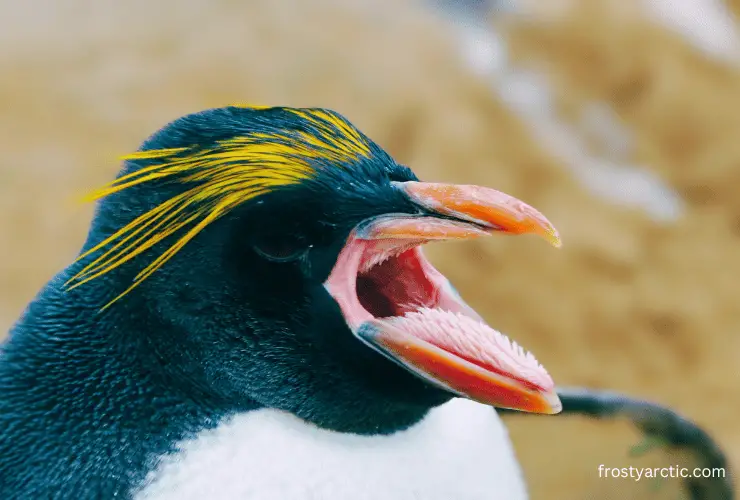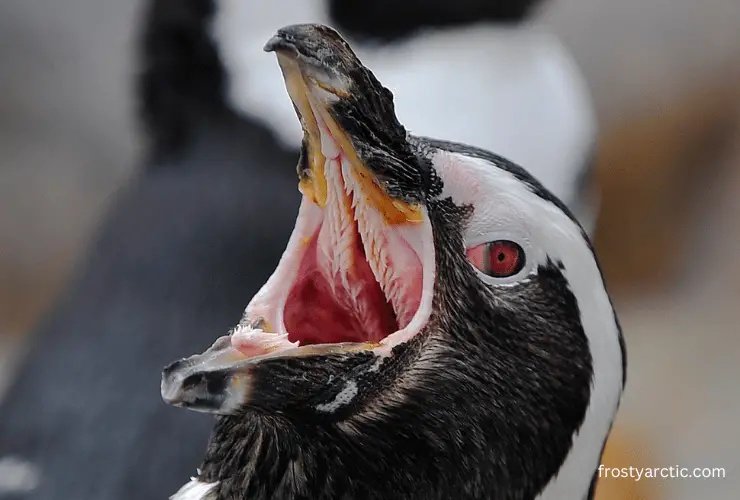Yes, penguins have tongues just like other birds. The tongue of a penguin is large and covered with backward-facing spines that help the penguin to grip and swallow its food. These spines are called papillae, which prevent slippery prey, like fish, from escaping the penguin’s beak.
However, penguins’ tongue lacks taste buds. Also, while penguin tongues may not be as visible as those of other animals, they play an important role in the penguin’s ability to catch and consume its prey and to maintain its body temperature.
Let’s learn more about the function of penguin tongues and the role they play in eating.
A Description of a Penguin’s Bill

A penguin’s bill is a distinctive feature that helps these aquatic birds to catch and consume their prey. The shape of a penguin’s bill varies across species and their differing diets.
Fun Fact: Penguins that eat fish have a long and thin bill, while it is shorter and stouter in penguins that consume krill. ~ SeaWorld.org
The bill is long, pointed, and slightly curved, with a sharp tip that enables the penguin to grasp and hold onto fish and other small animals.
It is also lined with spiny projections that help to prevent slippery prey from escaping, as well as a fleshy hook at the tip that assists in tearing and breaking apart food.
The color of the bill varies depending on the species, with some penguins having black, gray, or reddish-orange bills.
What Lies Inside a Penguin’s Mouth?

The inside of a penguin’s mouth contains a unique set of adaptations that help these birds to catch and consume their prey.
Inside a penguin’s mouth, they have a bill and a tongue but no teeth.
Penguin bills are lined with small spines that point back towards the bird’s throat, which helps to grip slippery prey and prevent them from escaping.
Additionally, the roof of the penguin’s mouth has a rough texture, which aids in grasping and holding onto prey. The tongue is also covered in spines that assist in moving food to the back of the mouth and swallowing it.
Spikes cover the roof of their mouths, making them look similar to stalagmites and stalactites present in caves. ~ Spadental. co. uk
Do Penguins Have Tongues? The Functions of Papillae on A Penguin’s Tongue
Penguins have tongues that are covered with tiny backward-facing spines called papillae. These papillae assist penguins in catching and holding onto slippery prey.
They also help to push food to the back of the penguin’s mouth and to swallow it.
Additionally, the papillae help to regulate the penguin’s body temperature by increasing or decreasing blood flow through the tongue.
What Does a Penguin’s Tongue Look Like? What Color Is a Penguin’s Tongue?

A penguin’s tongue is typically a large, muscular organ that is located at the back of its throat.
The tongue is covered in tiny, backward-facing spines known as papillae, which help the penguin to grip and swallow its food.
The tongue is not usually visible when the penguin’s beak is closed, as it is located at the back of the throat. However, the color of a penguin’s tongue is typically orange.
Despite the color variation, the tongue of a penguin serves an important function in helping the bird to catch and consume its prey.
Do Penguins Have Barbed Tongues?
Penguins have small spiny projections called papillae on their tongues, which help the bird to catch and hold onto slippery prey.
The main function of these fleshy ridges is to grip their slippery prey, not chew the fish. This means they are not barbed.
Why Do Penguins Have Spiky Tongues?
The spines on a penguin’s tongue play a critical role in helping penguins to catch and hold onto prey, such as fish and squid, while swimming at high speeds underwater.
The papillae on a penguin’s tongue function much like the spines on a cat’s tongue, allowing the bird to grasp and manipulate its food with precision.
The spines prevent prey from slipping out of the penguin’s beak, which is particularly important when hunting in fast-moving currents or turbulent waters.
Do Penguins Have Teeth on Their Tongue?

Penguins do not have teeth on their tongue, but they have tiny backward-facing spines that help them to grip and hold onto slippery prey.
Penguins don’t need teeth because they simply swallow their food without chewing and grinding.
These spines also help to direct the food toward the penguin’s throat, making it easier to swallow.
Although the tongue of a penguin serves a critical role in helping the bird to catch and consume its prey, it is not used for chewing or grinding food, as penguins do not have teeth in their beaks or mouths.
Do Penguins Have Taste Buds?
No, penguins do not have taste buds on their tongues. Research suggests that penguins cannot taste sweet, bitter, and umami flavors because they lack the receptors to taste these specific flavors.
This means they can only taste salty and sour foods.
According to researchers, the freezing of the Arctic region might have altered the taste receptors of the penguin’s ancestors, causing them to lose the ability to detect these flavors.
It is also possible that the cold temperatures disrupt the protein that sends the different taste signals to special organs or the nervous system. These taste signals include umami, sweet and bitter.
Frequently Asked Questions (FAQs):
Do penguins have teeth?
No, penguins do not have teeth; they have spikes on their tongue and the roof of their mouths.
Can penguins taste?
The two common flavors that penguins can taste are sour and salty. They lack receptors that detect different tasty flavors.
Can penguins taste their food?
Penguins can only partially taste their food because they can only detect taste salty and sour flavors.
What is the mouth of a penguin called?
The mouth of a penguin is not commonly referred to by a specific name, but it is comprised of several structures that work together to help the bird catch, consume, and digest its food.
Can penguins talk to each other?
Penguins use a variety of vocalizations, body postures, and visual cues. These vocalizations include squawks, brays, whistles, and trumpeting sounds, which are used to establish territory, attract mates, and communicate with other members of the colony.
Conclusion
These adaptations allow penguins to survive and thrive in the challenging environments of the Antarctic and sub-Antarctic regions, where they are often the top predators in their ecosystem.
I hope this article answers your question about the tongues of penguins.


